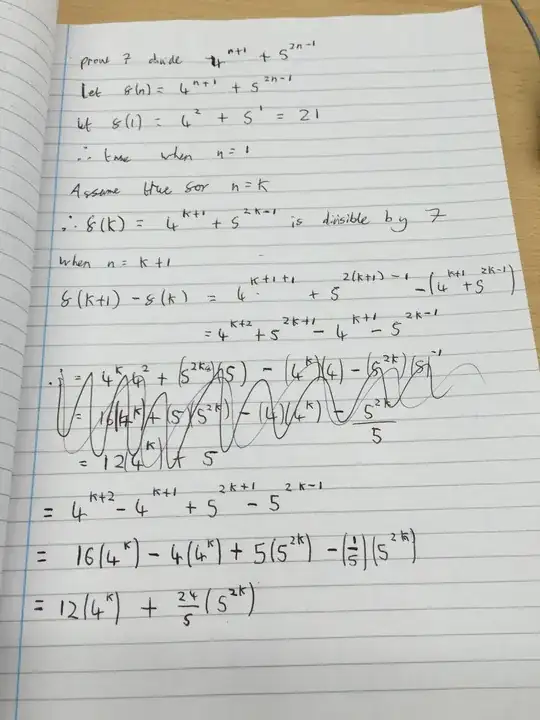My solution is: But I am not sure where I am going wrong. The answer I get is not divisible by 7.

- 10,143
- 147
-
Have you seen the notion of modulus. For example, $4^{n+1} \bmod 7$ is 4 if $n \bmod 3 = 0$. Computing the rest should be straightforward. If you have not seen modulus, forget this. – laurent Dec 13 '16 at 13:20
-
How do you divide by $5$ modulo $7$? – Bernard Dec 13 '16 at 13:21
7 Answers
HINT:
You have to prove the truth of $p(k+1)$ using $p(k)$, so you have to take out something from $p(k$) and then apply it to $p(k+1)$ to establish its truth.
As you have assumed that $p(k)$ is true. So, $4^{k+1}+5^{2k-1}$ must be divisible by 7 say it is $7m$ where $m$ is an integer. So you get $4^{k+1}+5^{2k-1}=7m$. Some flipping will give you $5^{2k-1}=7m-4^{k+1}$. Now How does $p(k+1)$ looks like??
It will look like $4^{k+2}+5^{2k+1}$. If we prove that $4^{k+2}+5^{2k+1}$ is divisible by $7$ then we are done. Try using $5^{2k-1}=7m-4^{k+1}$ to proceed further.
- 10,143
Hint: $4^{n+2}+5^{2n+1}=4(4^{n+1})+25(5^{2n-1})=4(4^{n+1}+5^{2n-1})+21(5^{2n-1})$.
- 40,402
First, show that this is true for $n=1$:
$4^{1+1}+5^{2-1}=21$
Second, assume that this is true for $n$:
$4^{n+1}+5^{2n-1}=7k$
Third, prove that this is true for $n+1$:
$4^{n+2}+5^{2n+1}=$
$4(4^{n+1})+25(5^{2n-1})=$
$(25-21)(4^{n+1})+25(5^{2n-1})=$
$25(4^{n+1})-21(4^{n+1})+25(5^{2n-1})=$
$25(4^{n+1})+25(5^{2n-1})-21(4^{n+1})=$
$25(\color\red{4^{n+1}+5^{2n-1}})-21(4^{n+1})=$
$25(\color\red{7k})-21(4^{n+1})=$
$7(25k)-21(4^{n+1})=$
$7(25k-3(4^{n+1}))$
Please note that the assumption is used only in the part marked red.
- 43,109
Hint
Write like this:
$$4^{k+2}-4^{k+1}+5^{2k+1}-5^{2k-1}=3\cdot4^{k+1}+24\cdot5^{2k-1}=3\cdot(4^{k+1}+5^{2k-1})+21.5^{2k-1}$$
Can you finish?
P.S: Use hyp induction for $k$ and note that $7|21$.
P.S: You can also prove that without use induction.
- 21,342
Better consider the expression: $$\delta(k+1) = 4^{k+2} + 5^{2k+1} = 4\times 4^{k+1} + 5^2\times 5^{2k-1} = 4[7m-5^{2k-1}] +5^{2k-1}(5^2) = [5^{2k-1} \times (5^2-4) +4(7m)] \mid 7$$ We considered $\delta(k) = 4^{k+1} +5^{2k-1} = 7m$ , since we know $7\mid \delta(k)$. Hope it helps.
-
You may find it of interest that proofs like the above are actually special cases of proofs of the CPR = Congruence Product Rule, as I explain in my answer here. CPR allows us to discover these inductive proofs much more easily. – Bill Dubuque Dec 14 '16 at 21:47
-
-
Glad to hear that. Alas, it seems not everyone agrees, since some user seems to frequently downvote these extended explanations (as you can see above). If you see anything that could be improved there I'd be grateful for feedback. These old beautiful ideas deserve to be much better known, since once you grok them problems like these become trivial. – Bill Dubuque Dec 15 '16 at 03:51
Note $5^2\equiv 4$ and $5^{-1}\equiv 3\mod 7$. Using this, we have: $$4^{n+1}+5^{2n-1}\equiv 4\cdot 4^n+(5^2)^n\cdot5^{-1}\equiv4\cdot 4^n+3\cdot 4^n=7\cdot4^n\equiv 0\mod 7.$$
- 175,478
Before considering your proof, let's gather some insight from a simpler proof using congruences. Below the inductive step follows very simply by using $\,\rm{\color{#C00}{CPR}} = $ Congruence Product Rule to multiply the first two congruences
$$\begin{align} {\rm mod}\,\ 7\!:\qquad\ 4\,\ &\equiv\,\ 5^{\large 2}\\[0.3em] 4^{\large K+1}&\equiv -5^{\large 2K-1}\ \ \ {\rm i.e.}\ \ P(K)\\ \overset{\rm{\color{#C00}{CPR}}}\Longrightarrow\ \ \ 4^{\large K+2}&\equiv -5^{\large 2K+1}\ \ \ {\rm i.e.}\ \ P(K\!+\!1) \end{align}$$
The common inductive proofs using divisibility in other answers effectively do the same thing, i.e. they repeat the proof of the Congruence Product Rule in this special case, but expressed in divisibility vs. congruence language (e.g. see here). But the product rule is much less arithmetically intuitive when expressed as unstructured divisibilities, which greatly complicates the discovery of the inductive step. I explain this at length in other answers, e.g. see here.
If congruences are unfamiliar then you can instead use the rule in divisibility form as below. This will allow you to structure the induction in the above intuitive arithmetical Product Rule form.
$$\begin{align} {\rm mod}\,\ m\!:\, A\equiv a,\, B\equiv b&\ \ \,\Longrightarrow\,\ \ AB\equiv ab\qquad\text{Congruence Product Rule}\\[3pt] m\mid A-a,\ B-b&\,\Rightarrow\, m\mid AB-ab\qquad\text{Divisibility Product Rule}\\[4pt] {\bf Proof}\quad (A-a)B+a(B&-b)\, = AB-ab\end{align}$$
To finish the proof that you started we can proceed as follows
$$\begin{align} f(k\!+\!1) - f(k) &=\, 3 \cdot 4^{\large k+1}+ \color{#0a0}{24}\cdot 5^{2k-1}\\ &=\, 3 \cdot 4^{\large k+1}+ \color{#0a0}3 \cdot 5^{2k-1} + \color{#0a0}{21}\cdot 5^{2k-1}\\ &=\, 3\, f(k) + 7n\\ \Rightarrow\qquad f(k\!+\!1)\, &=\, 4\, f(k) + 7n\\[0,3em] \Rightarrow\ \ 7\mid f(k\!+\!1)\,\ &{\rm if}\,\ 7\mid f(k), \ \ {\rm i.e.}\ \ P(k\!+\!1)\ \ {\rm if}\ \ P(k) \end{align}$$
Note that the above says that $\ f(k\!+\!1)\equiv 4\,f(k)\ \pmod{7}\,$
so an easy induction shows that $\ f(k)\equiv 4^{\large k-1}\, f(1)\pmod 7,\ $ so $\ 7\mid f(k)\iff 7\mid f(1)$
Now how using the Product Rule as above makes it much clearer that incrementing the index amounts simply to multiplication by $\,4,\,$ when viewed modulo $\,7.\,$ Once that innate arithmetical structure hs been revealed, the proof is easy.
- 272,048
